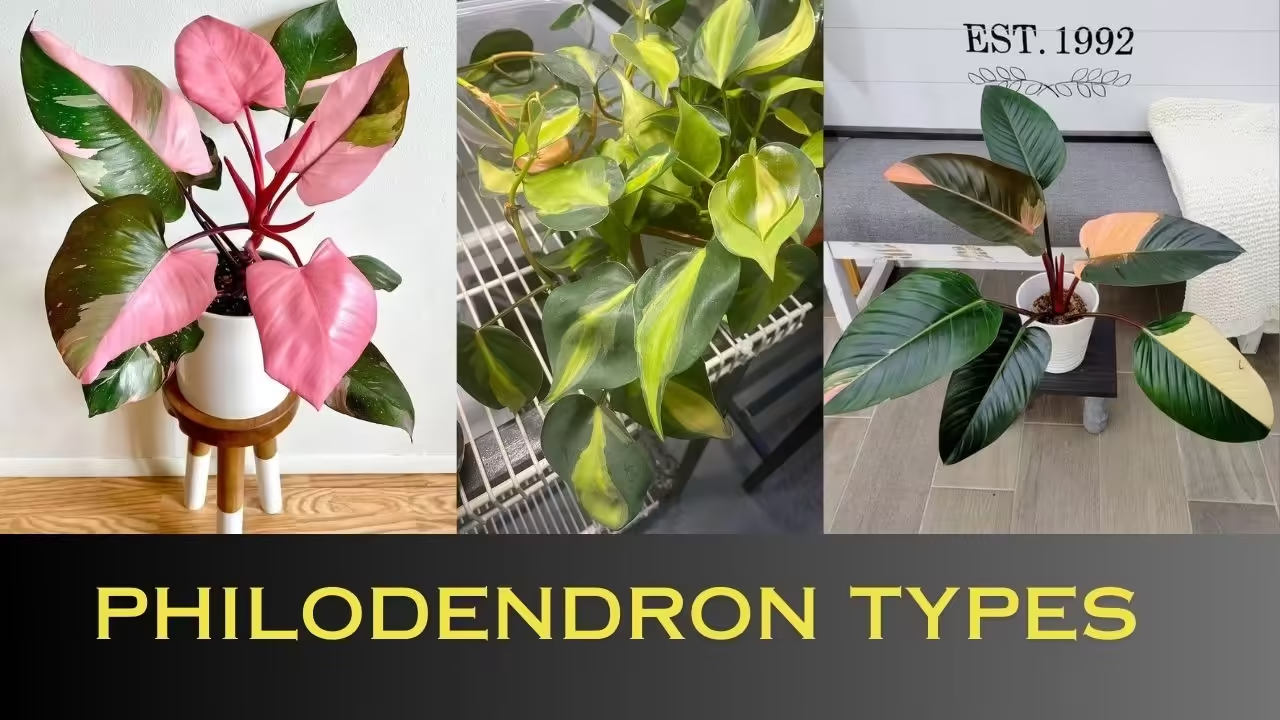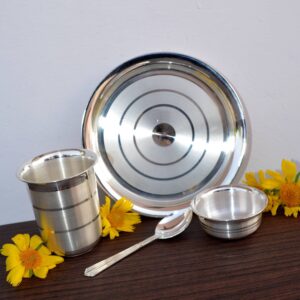Exploring the diverse world of philodendron types offers a glimpse into the vast array of foliage that this plant family boasts, captivating the hearts of indoor plant enthusiasts worldwide. These tropical plants, with their varied leaf shapes, sizes, and colors, have become a staple in households and offices for their beauty and ease of care. Understanding the different varieties is crucial for both novice and experienced plant owners, as each philodendron type brings its unique aesthetic and growing requirements to the table. This guide aims to shed light on the stunning diversity within the philodendron family, highlighting why they remain a popular choice for adding a touch of green to any space.
This article will explore thirty striking philodendron types, ranging from the elegant Philodendron Birkin with its distinctive white striping to the vibrant Philodendron Pink Princess, known for its pink variegated leaves. Other varieties such as Philodendron Brasil, Micans, Selloum, Xanadu, Prince of Orange, and many more will be covered, offering a comprehensive overview for enthusiasts looking to expand their collection or simply learn more about these fascinating plants. Each section will delve into the unique characteristics of these philadendrons, providing insights into their care, growth habits, and ideal environments, ensuring readers come away with a thorough understanding of the diverse world of philodendrons.
Philodendron Types
Philodendron Birkin
Description
Philodendron Birkin stands out due to its unique creamy white or yellow streaks on the green leaves, which may be a rare mutation of Philodendron ‘Rojo Congo’ or a hybrid of the cultivars ‘Congo’ and ‘Imperial Green’ 10137. This variety is characterized by a thick, upright, self-supporting stem that gives it a more tree-like appearance, making it an ideal plant for small spaces due to its slow-growing and compact nature 10137. The leaves of Philodendron Birkin are glossy, dark green, and feature striking variegation patterns that become more pronounced as the plant matures 89.
Care Tips
Philodendron Birkin is known for its easy-going nature, making it suitable for beginners 1114. It requires minimal pruning; only damaged or old leaves need to be removed to redirect energy to healthy foliage 107. Watering should be done only when the top layer of soil has dried out, as overwatering can lead to root rot 107. For optimal growth and health, it is recommended to water the plant every 1-2 weeks, allowing the soil to dry out between waterings 15.(Philodendron Types) Fertilization should be moderate, with a balanced, weak houseplant fertilizer applied every two months during the spring and summer to promote better growth and variegation 107.
Ideal Conditions
Philodendron Birkin thrives in a range of indoor lighting conditions but prefers bright, indirect light 1078. Direct sunlight should be avoided as it can scorch the leaves, while too little light can cause loss of variegation 107. The ideal temperature for this plant is between 65°F and 85°F (18°C to 29°C), and it should not be exposed to temperatures below 55°F (13°C) 1078. High humidity levels between 50% and 60% are favorable; however, the plant can adapt to average household humidity 8. Additional humidity can be provided through regular misting, using a humidifier, or placing the plant on a pebble tray filled with water 107.
Philodendron Brasil
Description
Philodendron Brasil, officially known as Philodendron hederaceum ‘Brasil’, is a vibrant cultivar celebrated for its unique variegation. The leaves of this vining houseplant feature a striking blend of lime-green against a backdrop of deep green, creating a visual contrast that enhances its appeal 221916. This variety is easy to care for and can add a splash of color to any indoor setting 1916.
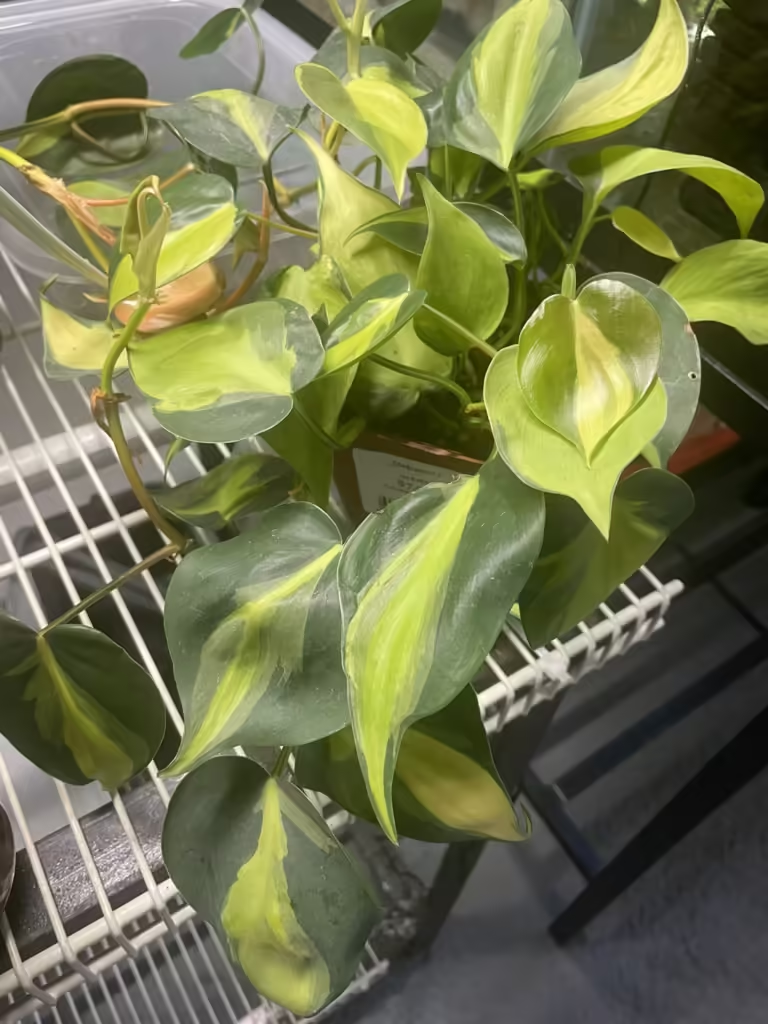
Care Tips
Caring for Philodendron Brasil involves a balance of proper lighting, watering, and soil conditions. It thrives in bright, indirect light, which helps maintain the vivid variegation on its leaves 222324. The soil should be well-draining and slightly acidic to support healthy growth 2219. Watering should be regular, allowing the top 2 to 3 inches of soil to dry out before watering again. It is crucial to avoid overwatering, as this can lead to root rot 2223. Monthly fertilization during the growing season with a balanced liquid houseplant fertilizer promotes lush, vibrant foliage 2219. Pruning can be done to control size and remove dead foliage, keeping the plant looking its best 2219. (Philodendron Types)
Ideal Conditions
Philodendron Brasil performs well under a range of indoor environmental conditions but displays optimal growth in warm, humid settings typical of its native tropical rainforest habitat 2219. While it can adapt to lower light, the variegation becomes more pronounced in brighter conditions 2324. However, direct sunlight should be avoided as it can scorch the leaves 1923. The ideal temperature range for this philodendron is between 65°F to 85°F (18°C to 29°C), and it should not be exposed to temperatures below 55°F (13°C) 2223. Increasing humidity around the plant can be achieved through methods like using a pebble tray or regular misting, which encourages more robust growth 2319.
Philodendron Micans
Description
Philodendron Micans, also known as Velvet Leaf Philodendron, is celebrated for its velvety, heart-shaped leaves that exhibit a stunning range of colors from deep green to red and maroon, depending on the light exposure 313233. This variety is native to the tropical regions of Mexico and the Caribbean and is recognized for its trailing growth habit, making it a perfect fit for hanging baskets or climbing on moss poles and trellises 313233.
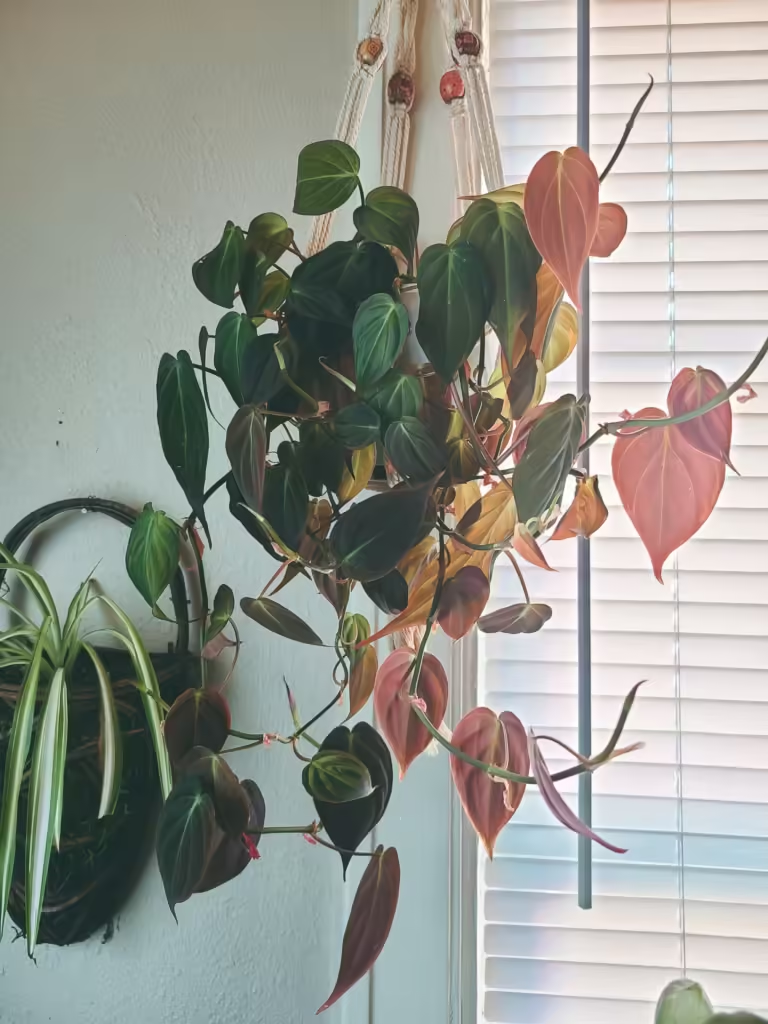
Care Tips
Caring for Philodendron Micans involves ensuring it receives bright to medium indirect light. Direct sunlight should be avoided as it can damage the leaves 3132. The plant prefers well-draining soil that is rich in organic matter. Watering should be done when the top 2-3 inches of soil are dry, and it is important to avoid overwatering to prevent root rot 3132. Philodendron Micans benefits from light fertilization with a balanced all-purpose fertilizer during the growing seasons of spring and summer 33.
Ideal Conditions
Philodendron Micans thrives in warm and humid conditions typical of its native tropical environment. The ideal temperature range for this plant is between 65°F to 80°F (18°C to 27°C). It is adaptable to average household humidity but benefits from higher humidity levels, which can be achieved using a pebble tray or humidifier 3133. This plant should be kept away from cold drafts and heating or cooling vents to avoid stress 33.
Philodendron Selloum
Description
Philodendron Selloum, also known as Thaumatophyllum bipinnatifidum, is a robust tropical plant with a striking presence, characterized by large, frilly, and deeply lobed leaves 3640. This variety, often found under the synonym Philodendron bipinnatifidum, is native to South America and thrives in a warm, humid environment 3442. Its leaves can grow up to almost 5 feet in their natural habitat, creating a dramatic tropical feel even in indoor settings 34. The plant typically grows as a shrub and may climb if near a support structure, adding a lush, jungle-like vibe to any space 38.
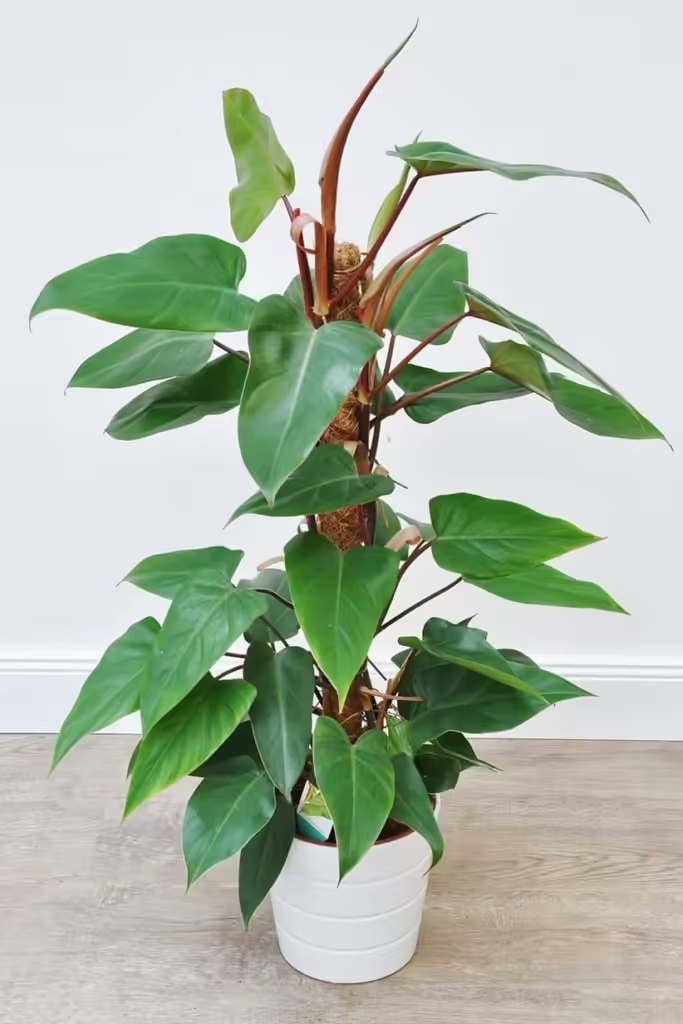
Care Tips
To maintain the health and beauty of Philodendron Selloum, it is essential to water the plant when the top two inches of soil are dry to the touch 37. Overwatering should be avoided to prevent root rot, and it is recommended to allow the soil to dry out slightly between waterings 3842. During the growing seasons of spring and summer, feeding the plant with a balanced liquid houseplant fertilizer monthly will support its growth 38. Regular pruning can help manage its size and remove any dead foliage, keeping the plant vibrant and healthy 38.
Ideal Conditions
Philodendron Selloum flourishes in bright, indirect sunlight but can tolerate medium light levels 3842. It should be positioned near a window where direct sunlight does not touch the foliage to prevent leaf burn 38. The ideal temperature range for this philodendron is between 65°F to 85°F (18°C to 29°C). It is adaptable to typical household humidity but benefits from higher humidity levels, which can be achieved through the use of a humidifier or pebble tray 3842. Rotating the plant periodically will ensure even growth and prevent the plant from leaning towards the light source 42.
Philodendron Xanadu
Description
Philodendron Xanadu, scientifically recognized as Thaumatophyllum xanadu, is a lush, tropical plant that was formerly categorized under the Philodendron (Philodendron Types) genus until its reclassification in 2018 4950. This plant is renowned for its large, glossy, multi-lobed leaves and dense, bushy growth, making it a striking addition to any indoor space 4950. The leaves are notably leathery with distinct lobes, and the plant can spread extensively, often reaching widths of up to 5 feet, which enhances its visual appeal as a full, robust houseplant 5046.
Care Tips
To ensure the health and vigor of Philodendron Xanadu, it should be placed in bright, indirect light and planted in a well-draining potting mix formulated for aroids 49. Watering should be moderate—allowing the soil to nearly dry out between sessions—and it is crucial to avoid overwatering to prevent root rot 49. During the growing seasons of spring and summer, the plant benefits from monthly fertilization with a balanced liquid fertilizer, adequately diluted to prevent fertilizer burn 4950. Additionally, to accommodate its growth, repotting should be done when it outgrows its current container 49.
Ideal Conditions
Philodendron Xanadu thrives in a warm, humid environment, typical of its native Brazilian rainforest 50. It prefers temperatures between 18°C to 28°C and can tolerate varying levels of humidity, though it benefits from additional humidity provided by methods such as pebble trays or humidifiers 5049. This plant should be shielded from direct sunlight to prevent leaf burn but can handle short periods of low light 49. Care should be taken to ensure the plant is not placed in overly dry or poorly ventilated areas, especially during colder months 50.
Philodendron Pink Princess
Description
The Philodendron Pink Princess, scientifically known as Philodendron erubescens ‘Pink Princess’, is a captivating variety that stands out with its heart-shaped, deep green leaves adorned with vibrant pink variegation 585960. This rare plant is native to Columbia and belongs to the Araceae family, thriving as a tropical aroid 585960. Its unique coloration, which includes shades ranging from bubblegum pink to deeper hues, makes it a top wish-list item for plant collectors 585960.
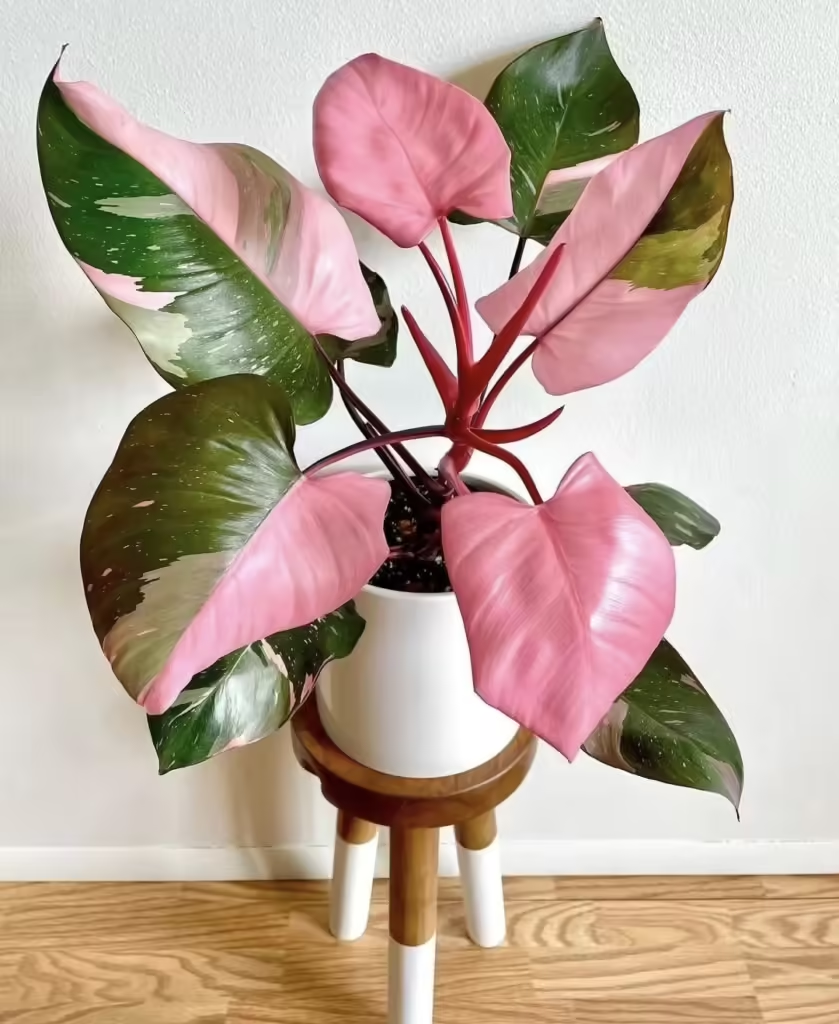
Care Tips
Proper care is crucial for maintaining the striking variegation of the Pink Princess. It is recommended to provide the plant with bright, indirect light for several hours a day. Although it can tolerate some direct light, too little light will cause the leaves to revert to green, losing their pink splashes 585960.
The ideal soil for this philodendron is airy, well-draining, and rich in organic matter, typically a mix of standard potting soil, perlite, and orchid bark 585960. Watering should be moderate, allowing the top half of the soil to dry out before watering again to avoid root rot 585960. Regular monthly feedings with a balanced liquid fertilizer during the growing season (spring and summer) are beneficial, but it is advised to stop fertilizing in early fall as the plant enters its dormant period 585960.
Ideal Conditions
The Pink Princess Philodendron(Philodendron Types) flourishes in warm, humid conditions, ideally between 65°F and 79°F (18°C to 26°C). It should be protected from temperatures below 60°F (15°C) to prevent stress 585960. While typical household humidity levels are adequate, higher humidity promotes healthier growth and can be achieved through methods like using a pebble tray or humidifier 585960. Regular misting or placing the plant in a naturally humid environment like a kitchen or bathroom also supports its lush appearance 585960.
Philodendron Prince of Orange
Description
The Philodendron Prince of Orange is a distinctive non-vining hybrid, renowned for its dynamic color-changing leaves. This plant begins with starburst yellow new growth that transitions through copper tones to a mature, darker green. Unlike many philodendrons that grow from vines, the Prince of Orange produces vibrant leaves directly from its center, creating a compact, bushy appearance similar to the Philodendron Congo but reaching only about 2 feet in height at full maturity 646566.
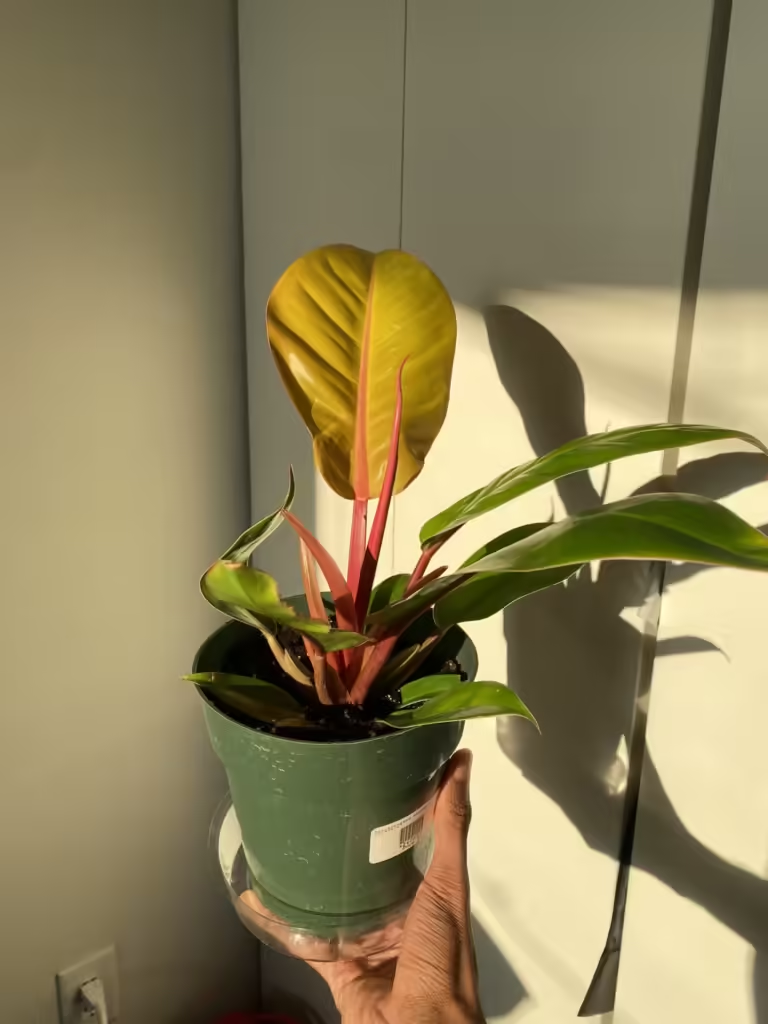
Care Tips
Caring for the Philodendron Prince of Orange involves ensuring the plant receives bright but indirect light and maintaining the soil consistently moist without becoming soggy. It is recommended to water the plant when the top 1-2 inches of soil feel dry, typically not more than once a week. To promote healthy growth, the plant benefits from monthly fertilization during the growing season with a balanced, water-soluble fertilizer, diluted to half strength. Pruning is minimal, focusing only on removing yellow or damaged leaves to encourage a bushier growth 646566.
Ideal Conditions
The ideal environment for the Philodendron Prince of Orange includes a warm and humid setting with temperatures ranging between 60°F and 85°F (15°C to 29°C). The plant thrives in high humidity, which can be enhanced by placing it on a pebble tray with water or using a humidifier. It is crucial to avoid direct sunlight, which can scorch the leaves, and to protect the plant from cold drafts. Regular rotation of the plant ensures even growth and maintains the vibrant coloration of the foliage 6566
Philodendron oxycardium (Heartleaf Philodendron)
Description:
The Heartleaf Philodendron is a classic, easy-to-care-for plant with heart-shaped leaves. It is perfect for beginners due to its hardy nature and adaptability to various indoor conditions. This plant can be grown as a trailing vine or trained to climb a support.

Care Tips:
Light: Thrives in low to bright indirect light. Too much direct sunlight can cause the leaves to turn yellow, while low light conditions may slow down growth.
Water: Water when the top inch of soil is dry. Avoid overwatering, as this can lead to root rot.
Humidity: Average household humidity is sufficient, but it benefits from occasional misting.
Soil: Well-draining potting mix. A standard houseplant mix works well.
Propagation Tips:
Stem Cuttings: Take a cutting with a few leaves and a node. Place in water or soil to root. Cuttings root quickly and easily, making this a great plant for propagation.
Philodendron gloriosum
Description:
Philodendron gloriosum(Philodendron Types) is admired for its large, velvety, heart-shaped leaves with prominent white veins. This terrestrial plant grows horizontally, making it distinct from many other climbing or vining philodendrons.
Care Tips:
Light: Bright, indirect light is ideal. Avoid direct sunlight, which can scorch the leaves.
Water: Keep the soil consistently moist but not waterlogged. Water when the top inch of soil feels dry.
Humidity: Prefers high humidity. Use a humidifier or place on a pebble tray with water to maintain 60-80% humidity.
Soil: Well-draining, rich potting mix with added perlite and peat moss.
Propagation Tips:
Rhizome Division: Divide the rhizome with a sharp, sterile knife, ensuring each section has roots and at least one leaf. Plant the sections in individual pots with appropriate soil.
Philodendron Ceylon Golden (Philodendron ‘Golden Emerald’)
Description:
This Philodendron variety(Philodendron Types) is known for its vibrant lime-green to golden-yellow leaves that brighten any space. Its striking color makes it a standout in any plant collection.
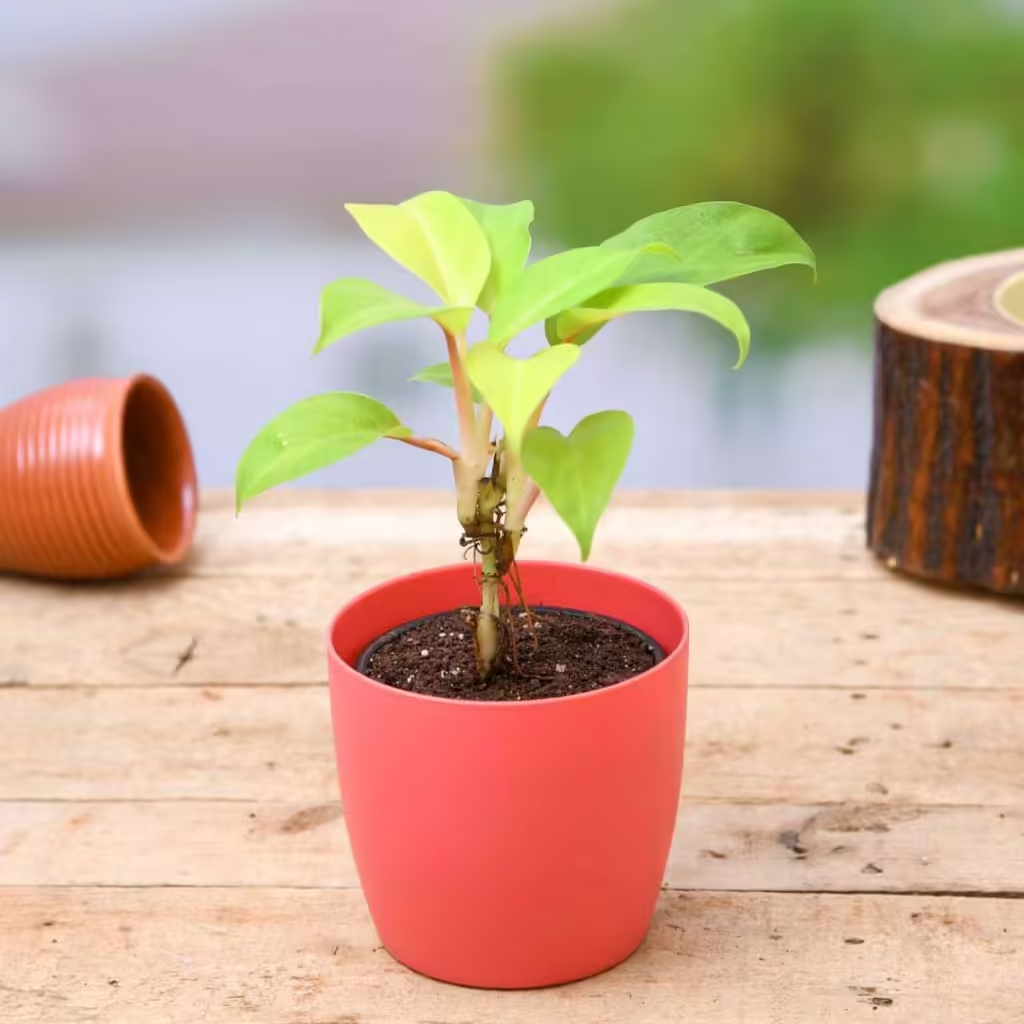
Care Tips:
Light: Bright, indirect light. Too much direct sunlight can bleach the leaves, while too little light can cause the plant to lose its vibrant color.
Water: Keep the soil slightly moist. Water when the top inch of soil is dry.
Humidity: Prefers higher humidity levels, around 60-80%.
Soil: Well-draining potting mix with good organic content.
Propagation Tips:
Stem Cuttings: Cut a stem with a node and place in water or soil to root. Ensure the cutting is healthy and free from pests.
Philodendron Red Plant (Philodendron erubescens)
Description:
The Philodendron Red Plant features striking red stems and dark green leaves with a reddish hue. This robust plant adds a bold splash of color to any indoor garden.
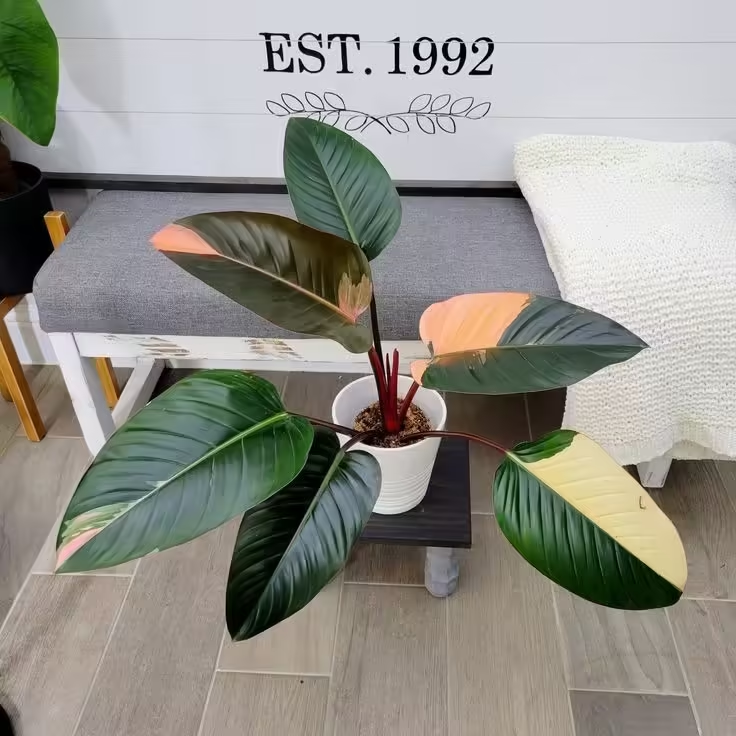
Care Tips:
Light: Bright, indirect light. It can tolerate lower light levels but will grow more slowly.
Water: Keep the soil slightly moist. Allow the top inch of soil to dry out between waterings.
Humidity: Prefers higher humidity levels, around 60-80%.
Soil: Well-draining potting mix.
Propagation Tips:
Stem Cuttings: Cut a stem with a node and place in water or soil to root. Ensure the cutting has at least one leaf.
Philodendron Moonshine
Description:
Philodendron Moonshine(Philodendron Types) is known for its silvery-green leaves, adding a unique touch to any plant collection. The light, almost reflective foliage sets it apart from other Philodendrons.
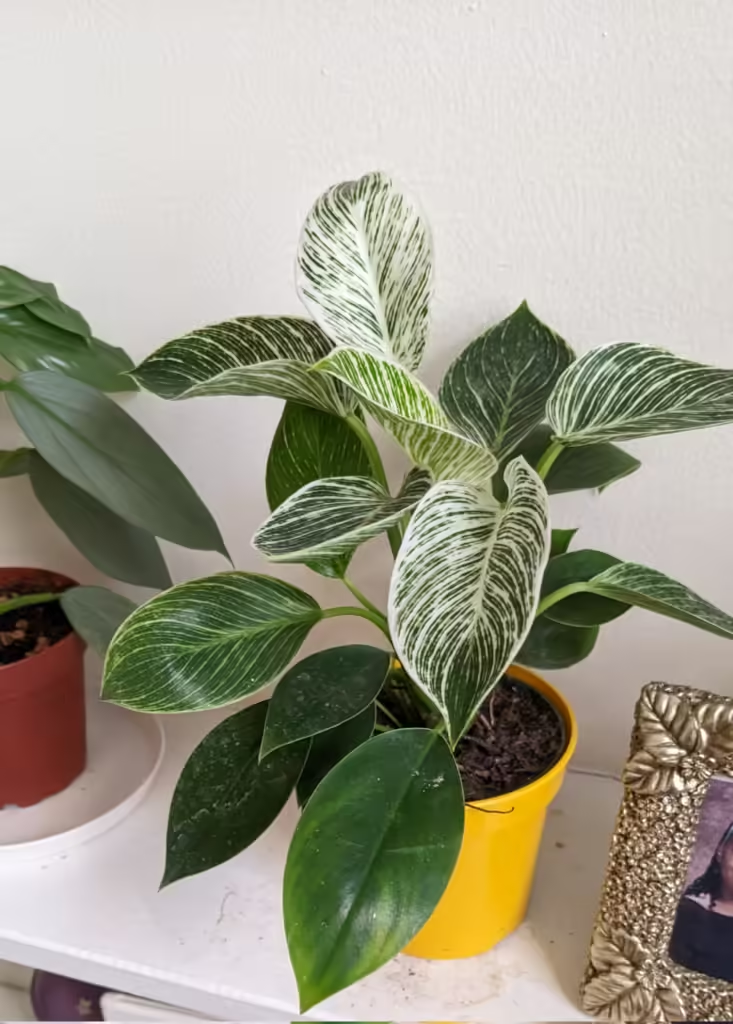
Care Tips:
Light: Bright, indirect light. Avoid direct sunlight, which can cause leaf burn.
Water: Water when the top inch of soil is dry. Consistent moisture helps maintain its striking leaf color.
Humidity: Prefers higher humidity levels, around 60-80%.
Soil: Well-draining potting mix with added perlite or orchid bark.
Propagation Tips:
Stem Cuttings: Cut a stem with a node and place in water or soil to root. Healthy cuttings will root within a few weeks.
Philodendron Florida Ghost
Description:
Philodendron Florida Ghost is a rare variety known for its ghostly white new leaves that turn green as they mature. Its unique foliage makes it a prized possession for plant collectors.
Care Tips:
Light: Bright, indirect light. Sufficient light helps maintain the white coloration in new leaves.
Water: Keep the soil slightly moist. Allow the top inch of soil to dry out between waterings.
Humidity: Prefers higher humidity levels, around 60-80%.
Soil: Well-draining potting mix with good organic content.
Propagation Tips:
Stem Cuttings: Cut a stem with a node and place in water or soil to root. Ensure the cutting is taken from a healthy part of the plant to increase rooting success.
Philodendron Jose Buono
Description:
Philodendron Jose Buono(Philodendron Types) is known for its large, variegated leaves that display a beautiful mix of green and creamy white. The unique and bold patterning makes this variety a standout in any plant collection.
Care Tips:
Light: Bright, indirect light to maintain variegation. Too much direct sunlight can scorch the leaves.
Water: Keep the soil slightly moist but not waterlogged. Allow the top inch of soil to dry out between waterings.
Humidity: Prefers higher humidity levels, around 60-80%.
Soil: Well-draining potting mix with added perlite or orchid bark to ensure good aeration and drainage.
Propagation Tips
Stem Cuttings: Cut a healthy stem with at least one node and place it in water or directly into moist soil to root. Ensure the cutting is taken from a part of the plant with good variegation.
Cost: $50 – $200, depending on the size and variegation.
Philodendron Snowdrift
Description:
Philodendron Snowdrift is admired for its large, variegated leaves with a mix of green and creamy white. The leaves have a marbled appearance that adds a touch of elegance to any indoor space.
Care Tips:
Light: Bright, indirect light. Avoid direct sunlight, which can cause leaf burn.
Water: Water when the top inch of soil is dry. Consistent moisture helps maintain healthy growth.
Humidity: Prefers higher humidity levels, around 60-80%.
Soil: Well-draining potting mix with good organic content.
Propagation Tips:
Stem Cuttings: Cut a stem with at least one node and place it in water or soil to root. Healthy cuttings will root within a few weeks.
Cost: $75 – $250.
Florida Beauty Philodendron
Description:
Florida Beauty Philodendron(Philodendron Types) is a rare and stunning plant with highly variegated leaves that feature a blend of green, yellow, and cream. Its unique foliage makes it a prized possession for collectors.
Care Tips:
Light: Bright, indirect light to maintain its vibrant variegation.
Water: Keep the soil slightly moist. Allow the top inch of soil to dry out between waterings.
Humidity: Prefers higher humidity levels, around 60-80%.
Soil: Well-draining potting mix with added perlite or orchid bark.
Propagation Tips:
Stem Cuttings: Cut a stem with a node and place it in water or soil to root. Ensure the cutting is taken from a healthy part of the plant to increase rooting success.
Cost: $100 – $400, depending on size and variegation.
Philodendron Gabby
Description:
Philodendron Gabby is known for its beautiful, heart-shaped leaves that come in a mix of green and creamy white. Its variegation pattern is quite unique, making it a favorite among plant enthusiasts.
Care Tips:
Light: Bright, indirect light. Too much direct sunlight can bleach the leaves.
Water: Water when the top inch of soil is dry. Avoid overwatering, as this can lead to root rot.
Humidity: Prefers higher humidity levels, around 60-80%.
Soil: Well-draining potting mix.
Propagation Tips:
Stem Cuttings: Take a cutting with a few leaves and a node. Place it in water or soil to root. Cuttings root quickly and easily, making this a great plant for propagation.
Cost: $30 – $100.
Philodendron Strawberry Shake
Description:
Philodendron Strawberry Shake(Philodendron Types) is admired for its stunning, variegated leaves with splashes of pink, yellow, and cream on a green background. This plant is highly sought after for its unique and colorful foliage.
Care Tips:
Light: Bright, indirect light to maintain its vibrant variegation.
Water: Keep the soil slightly moist but not waterlogged. Allow the top inch of soil to dry out between waterings.
Humidity: Prefers higher humidity levels, around 60-80%.
Soil: Well-draining potting mix with added perlite or orchid bark.
Propagation Tips:
Stem Cuttings: Cut a healthy stem with at least one node and place it in water or soil to root. Ensure the cutting has good variegation to increase the chances of maintaining the colorful foliage.
Cost: $200 – $600, depending on size and variegation.
Philodendron Patriciae
Description:
Philodendron Patriciae(Philodendron Types) is known for its elongated, ribbed leaves that create a striking appearance. The leaves have a dark green color with prominent veining, adding texture and interest to your plant collection.
Care Tips:
Light: Bright, indirect light. Too much direct sunlight can scorch the leaves.
Water: Keep the soil slightly moist but not waterlogged. Allow the top inch of soil to dry out between waterings.
Humidity: Prefers higher humidity levels, around 60-80%.
Soil: Well-draining potting mix with added perlite or orchid bark to ensure good aeration and drainage.
Propagation Tips:
Stem Cuttings: Cut a stem with a node and place it in water or soil to root. Healthy cuttings will root within a few weeks.
Cost: $100 – $300.
Orange Princess Philodendron
Description:
The Orange Princess Philodendron features vibrant, orange-red new leaves that mature to a deep green. This stunning color transition makes it a standout in any indoor garden.
Care Tips:
Light: Bright, indirect light to maintain the vibrant orange coloration.
Water: Water when the top inch of soil is dry. Avoid letting the soil dry out completely.
Humidity: Prefers higher humidity levels, around 60-80%.
Soil: Well-draining potting mix with added perlite or orchid bark.
Propagation Tips:
Stem Cuttings: Cut a stem with at least one node and place it in water or soil to root. Ensure the cutting is taken from a healthy part of the plant to increase rooting success.
Cost: $50 – $150.
Philodendron Red Sun
Description:
Philodendron Red Sun is known for its striking red leaves that add a bold splash of color to any indoor space. The vibrant foliage makes it a popular choice for plant collectors.
Care Tips:
Light: Bright, indirect light to maintain the vibrant red coloration.
Water: Keep the soil slightly moist. Allow the top inch of soil to dry out between waterings.
Humidity: Prefers higher humidity levels, around 60-80%.
Soil: Well-draining potting mix with added perlite or orchid bark.
Propagation Tips:
Stem Cuttings: Cut a stem with a node and place it in water or soil to root. Healthy cuttings will root within a few weeks.
Cost: $40 – $120.
Philodendron Whipple Way
Description:
Philodendron Whipple(Philodendron Types) Way is a rare and unique variety with dark green, deeply lobed leaves. The dramatic foliage adds a touch of elegance and sophistication to any plant collection.
Care Tips:
Light: Bright, indirect light. Avoid direct sunlight, which can cause leaf burn.
Water: Water when the top inch of soil is dry. Consistent moisture helps maintain healthy growth.
Humidity: Prefers higher humidity levels, around 60-80%.
Soil: Well-draining potting mix with good organic content.
Propagation Tips:
Stem Cuttings: Cut a stem with a node and place it in water or soil to root. Ensure the cutting is taken from a healthy part of the plant to increase rooting success.
Cost: $80 – $250.
Detailed Propagation Tips for Philodendrons
Choosing the Right Time and Tools
Timing: The best time to propagate(Philodendron Types) Philodendrons is during the growing season, typically spring and summer. During these periods, the plant is actively growing and can recover and establish roots more quickly.
Tools: Use sharp, sterile scissors or a knife to make clean cuts. This reduces the risk of introducing pathogens to the plant.
Methods of Propagation
Stem Cuttings:
Selection: Choose a healthy stem with at least one node and a few leaves. Nodes are essential as they contain the necessary cells for root development.
Cutting: Cut just below a node to include the node in the cutting. This is where roots will form.
Rooting Medium: Place the cutting in water or directly into moist soil. Both methods are effective, though water rooting allows you to monitor root growth.
Care: Keep the cutting in a warm, humid environment with bright, indirect light. Change the water regularly if rooting in water, and keep the soil slightly moist if rooting in soil.
Rhizome Division (for Philodendron gloriosum):
Division: Carefully remove the plant from its pot and gently separate the rhizome into sections, ensuring each section has roots and at least one leaf.
Planting: Plant the divided sections in individual pots with appropriate soil.
Care: Provide high humidity and keep the soil consistently moist to help the divisions establish.
Air Layering:
Method: Make a small incision on a healthy stem and wrap it with moist sphagnum moss. Cover the moss with plastic wrap to retain moisture.
Roots: Once roots develop, cut the stem below the new roots and plant in soil.
FAQS
Which philodendron variety is considered the best?
The heartleaf philodendron is regarded as one of the best and most popular varieties due to its attractive appearance and ease of cultivation. It features small, heart-shaped, jade green leaves and a vining growth pattern, making it ideal for hanging baskets and planters.
How many different types of philodendron exist?
There are over 450 recognized species within the Philodendron genus, making it one of the largest families of its kind. These species vary widely in leaf shape, color, and growth habits, highlighting their incredible diversity.
What is the rarest philodendron species?
The Philodendron Spiritus Sancti stands out as one of the rarest philodendron species. Originally discovered in the dense jungles of Central and South America, its rarity has turned it into a legendary figure among plant enthusiasts.
How often should I water my Philodendron?
water when the top inch of soil feels dry. Overwatering can lead to root rot. It's essential to strike a balance between keeping the soil moist and avoiding waterlogging.
Can Philodendrons grow in low light?
While many Philodendrons can tolerate low light, they thrive best in bright, indirect light. Low light can slow growth and reduce leaf size.
How do I increase humidity for my Philodendrons?
Increase humidity by misting the plants regularly, using a humidifier, or placing the pots on a pebble tray with water. Grouping plants together can also help create a more humid microenvironment
What type of soil is best for Philodendrons?
A well-draining potting mix with added perlite, orchid bark, or peat moss is ideal for Philodendrons. The soil should retain moisture without becoming waterlogged.
How can I prevent pest infestations on my Philodendrons?
Regularly inspect your plants for pests, keep the foliage clean, and use insecticidal soap or neem oil if necessary. Maintaining good air circulation around the plants can also help prevent pests.
What should I do if my Philodendron’s leaves turn yellow?
Yellowing leaves can be a sign of overwatering, underwatering, or inadequate light. Check the soil moisture level and light conditions to identify and correct the issue.
Can I grow Philodendrons outdoors
Philodendrons can be grown outdoors in warm, tropical climates where temperatures do not drop below 50°F (10°C). They should be placed in a shaded or semi-shaded area to avoid direct sunlight.
How often should I fertilize my Philodendron
During the growing season (spring and summer), fertilize every 4-6 weeks with a balanced, water-soluble fertilizer. Reduce feeding in the fall and winter when growth slows.
How large do Philodendrons grow?
The size of a Philodendron depends on the variety. Some, like the Heartleaf Philodendron, stay relatively small, while others, like Philodendron gloriosum, can grow large, spreading leaves.
What are the disadvantages of philodendrons?
The primary disadvantage of philodendrons is their toxicity. Ingestion of any part of the plant can lead to severe discomfort in both humans and pets, including symptoms like burning and swelling of the mouth, vomiting, and diarrhea. Additionally, contact with the plant's sap may cause skin irritation.
For more Philodendron Varieties Please Click Here
